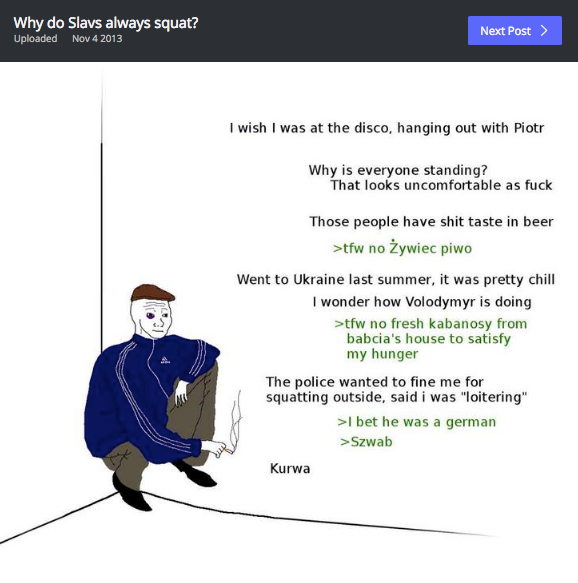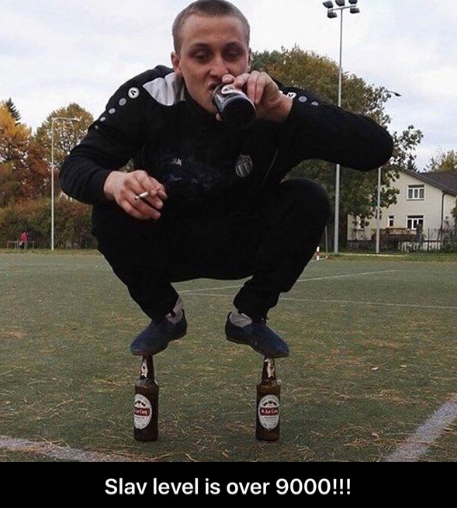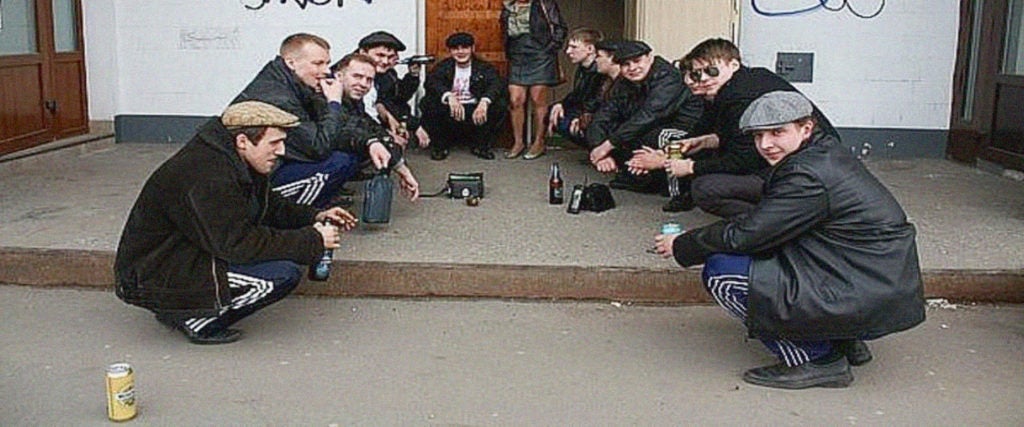Probably without you noticing it, you’ve acquired this stereotype of a young Russian man. He favors Adidas tracksuits, newsboy hats and pointed leather shoes. He smokes cheap cigarettes and drinks cheap beer or vodka. Between his expression and his surrounding, you associate him with poverty and its attendant crime. But if you know one thing about him, you know this: He is almost always crouched in a “Slav squat.”

Over nearly a decade, the Slav squat has become ingrained as an internet meme, partially on the strength of the question it poses: Namely, “Why do Slavs squat?” But the bigger mystery, it turns out, is how we received the idea that they do. In a new episode of their wonderful podcast covering U.S.-Russia relations, She’s in Russia, best friends Smith Freeman and Olivia Capozzalo go deeper than anyone has yet to describe how the Western world came to be fascinated by this archetype of a lower-class loiterer, the so-called gopnik.
What I was most surprised to learn (and this speaks to the assumptions that come with a life spent on the American internet) is that these guys weren’t exactly trying to build a reputation for an international audience. Somewhere in the back of my mind, I figured any “squatting Slav” would upload these photos to social media himself — that this was the image he wanted to project, an idealized pose.
You vs the guy she tells you not to worry about pic.twitter.com/uYOktEB8An
— Squatting Slavs ✪7476 (@SquattingSlavs) August 15, 2016
In fact, Freeman and Capozzalo explain, “gopnik” originated as a derogatory term — not unlike “trailer trash” in the states — and it wasn’t until recently that some gopniks, or gopniki, embraced this identity with the mixture of pride and irony we expect from an internet-codified subculture.
It was Slavic meme creators who saw the content-potential in this group, and before viral fame, few gopniki would have seen themselves as affecting a style, per se, only living normally. Their image, as we know it, is largely informed by other Slavs mimicking them. This is an aesthetic, then, controlled, and in a sense, projected onto a people by outsiders: It’s an attempt to make sense of dudes whose social roots go back a century, and whose development is tied up in the grander Soviet narrative. But I’ll let the actual Russia experts unpack that stuff for you here:
Because the gopnik phenomenon has such staying power, revealing so much in how jokes, prejudices and economic identifiers translate from one side of the globe to another, I wanted to ask a few more questions — especially on matters Freeman and Capozzalo had time to only briefly mention in the podcast. It’s a slippery and inexhaustible topic.
This interview has been edited for length and clarity.
Early in the podcast, we hear that the gopnik is one of the few images of a stereotypical Russian known outside of the country itself. How exactly do actual Russians — and not just the gopniki — feel about that?
Freeman: How Russians feel about the gopnik image is probably on a person-by-person basis. I’d venture to guess that Russians, like Americans, would probably want the most nuanced image of themselves as people to be portrayed to the global audience. As in the often reductive and negative image of Russians as spies or hackers or intolerant or untrustworthy doesn’t feel very good (or accurate for that matter). Needless to say, the gopnik image isn’t particularly nuanced. But it’s an image that has for the most part been created and propagated by Slavs themselves. And if you read the discussion threads on things like Slav Squatting and knock-off Adidas tracksuits, you’ll find a fair amount of Slavic pride tied up in the ironic image of the gopnik — despite gopnik being, at least originally, a derogatory term.
Capozzalo: Here are some responses I got from my Russian friends [she lives in St. Petersburg] when asking them (a) what they think about the fact that the image of the gopnik (as a meme) has a lot of popularity outside of the former USSR, and specifically in the West, and (b) more precisely, what do you think about the fact that this is one of the most popular stereotypical images of a Russian person in Western mass culture?
Maksim: OMG. Is it? I guess the problem lies in the 1990s, after the fall of Soviet Union. When Russia became open to the West. At the same time a lot of criminals started to raise capital (both legally and illegally). With made money they started to travel without knowledge of what the West actually was. So they brought that image to the West as Russians: gopnik with money.
Any stereotypical image is the first impression that foreigners make about. And I’m ashamed to be interpreted with that image both consciously and unconsciously.
As a Russian, I always have problems abroad. Because of our politics, government, stereotypes. I usually never say where I’m from. Thank god it’s hard to guess looking at me.
Nastya: Is it, though? I can’t remember the last time I saw a gopnik represented in a movie or something. I feel like [an] uneducated, rude but somewhat funny dude is a more often character. Or is it a gopnik? Anyway. It’s sad, though, that a dumb irrelevant asshole represents Russians in mass [culture]. You know the movie Happiness? There’s a storyline about a pedophile, but a Russian gopnik is still the worst character!
Blyat this explains alot. @life_of_boris #gopnik pic.twitter.com/9TzakvNdMH
— ECH! (@kmeier2001) March 15, 2018
I’m intrigued by how essential language was to a meme system we think of as visual — for example,“Slav squat” was an English term that wound up retranslated back into anglicized Russian. Do the languages usually cross-pollinate this way, or is this a weird exception?
Capozzalo: The important thing to emphasize when we talk about language in the gopnik meme is the fact that the culture from which the meme arose (Russian, Soviet) can refer to it and make memes from it with more variation, linguistically and visually (they know what the original phenomenon is, so they can better meme it). By “linguistically,” I just mean that Russian-speakers can (and do) make fun of gopniks in real life and on the internet by saying/writing actual phrases that are stereotypically attributed to real live gopniks (e.g, “падай на корты,” or, roughly, “pop a squat”). Russians can do gopnik mannerisms, mimic vocal inflections, etc., to each other — they simply have more material to work with than someone outside of the culture as a whole.
So when one particular aspect of the gopnik image (the squat) is focused on in the English-speaking internet, it’s done from an outside perspective (regardless of whether or not the person/people who coined the term “slav squat” and/or the people who use it are actually from a slavic/Russia/Soviet culture doesn’t really matter; the term is naming the thing from the outside). Also, just a side note: It makes sense to use English if you want something on the internet to reach the largest possible audience. Also I want to note, if it wasn’t clear: Russian-speaking people do not often use the direct translation of “slav squat(ing)” in Russian, I just have seen it here and there, specifically as a translation of the English phrase.
In terms of language cross-pollination between Russian and English in general, I would say the directionality is overwhelmingly English → Russian. That is just given the imperial dominance of American pop culture and the English language more generally worldwide. I know it’s not the same thing at all, but there are lots of examples of little English words or phrases that Russians use in everyday speech, like “come on,” “really” and “seriously” — all just said in English, but pronounced with a Russian accent, and just flowing in speech between Russian words.
Freeman: The “Slav squat” meme and the broader internet culture of which it is a part is heavily Slavic (and when I say Slavic, I mean people who consciously and explicitly refer to some kind of pan-Slavic culture, which includes people from a number of countries from the former USSR, who may or may not themselves be ethnically Slavic), rather than specifically Russian (even though gopnik is a Russian word). It’s in the Slavic internet vs. the Runet [the Russian-language internet], meaning not everyone speaks the same language. For example, ethnic Russians and Poles are both Slavic but speak different languages (with a different alphabet). This explains why the meme at least starts in English and probably why the retranslation of “Slav squat” is not actually all that popular to use, even in the Runet.
I think, though, that it would be safe to assume that any meme that comes from the Slavic internet has some potential for language cross-pollination simply because its creators and consumers are multilingual. And also because there’s not really a hard line between Ru/Slavic/English internet. Here’s an example of a gopnik-related meme in Polish and English:

Here is a popular style of illustration about the Slavic countries in English and transliterated Russian, that, though readable to any English speaker, may not be comprehensible without a fair amount of understanding of Slavic history. This tends to be the case across the board with many of these memes.
I think this creates a cool effect, and I would speculate that it plays a role in the memes’ popularity in the West. The memes feel authentically Slavic by requiring knowledge to understand them, but because they are in English, they present an opportunity for the consumer to learn enough to decipher them. I think for English-speaking Westerners who like learning about Russian and Slavic cultures, understanding these memes makes them feel good.
I think you see less language cross-pollination when you are dealing solely with the English speaking internet or the Runet (where memes will be predominantly in Russian, like this). Though you do see a fair amount of movement of internet memes to the Runet, wherein Russian is superimposed on an image macro first popular on the Internet (like this guy). I bet there are examples of internets that map to “macro”-ethnic groups, like Slavs, and I bet you would get similar language cross-pollination there, I just don’t know any of them myself. Someone should tell us about, like, Southeast Asian internet culture.
You briefly addressed proper “Slav squat” form. Can you tell me the essential aspects of the pose? Are either of you especially good at it? Olivia mentioned she squats more than the Russians she knows—how did she get in the habit?
Freeman: Boris explains it best:
Capozzalo: It’s really funny to try to seriously answer this. You just squat. And yes, as Boris says, keeping your heels down is important for the true Slav squat. I mean, I just originally would do it as a joke, pose that way in a photo, and in different circumstances it was potentially hip-hop-inspired and/or gopnik-inspired, but not with too much thought put into it. Russians got a kick out of it when I did it, and drew attention to the gopnik reference, namely verbally (for example, saying gopnik phrases to me and trying to get me to repeat them while squatting, because it’s extra funny for an American to do it, lol).
Very occasionally I actually have squatted in public for convenience purposes. Like once I was waiting in a long line to board a plane, and they had us in this little in-between area where there were no seats. So rather than sitting on the floor (something I am definitely not against, but I’ve found myself more averse to since living in Russia, because it seems more discouraged here), I just squatted because I was tired of standing and it was comfortable. I think some of the Russians (I was flying from Finland to Russia if I recall correctly) in line were probably smiling or smirking at me, but I avoided making eye contact with people because it was slightly embarrassing.
You didn’t get a chance to go into the women of the gopnik scene, but I’ve seen a fair amount of memes where women at least imitate the style. How do they figure into the equation? Is there a related stereotype of them? Is the squatting itself essentially masculine or not?
Capozzalo: I think it bears repeating that the majority of gopnik memes feature people mimicking gopniks, rather than actual straight up gopniks themselves, who are, as I’ve read, not a particularly self-referential, self-ironicizing subculture. Again, the word “gopnik” in Russian is derogatory and generally people who might be called gopniks, especially in the heydey of phenomenon in the ’90s, do not refer to themselves with that word!
I, too, have seen images of both men and women slav squatting in tracksuits on the internet, yes. But I get the sense that the actual groups of squatting people who drink (drank) beer and eat (ate) sunflower seeds and are called gopniks by other people together are majority-masculine. It kind of reminds me of how in lots of cultures groups men gather around in cafes and other public spaces to play dominoes (or something), or just shoot the shit. I think squatting in particular is seen as unfeminine, and thus kind of crude/crass for a lady to do it (again, if you’re doing it seriously, not ironically) — like, that is what I imagine men who actually squat think of women squatting. I could be wrong though, I unfortunately do not know any real gopniks…
I get the sense that gopnitsa is the again derogatory Russian word for a female person you think looks like they would date/hang out with a gopnik. Could be clothes, makeup, hair, but I doubt it would be the squat. But those are all just visual signals. Remember, gopnik is more a reference to a lifestyle/class overall.

Which is more key to the gopnik archetype, the squat or the tracksuit? Or is it the combination that locks the idea together? You mentioned athletics/workout culture as well as hip-hop influences, and it occurs to me that squatting has associations with both exercise. And then there’s the “rap squat,” too.
Freeman: The gopnik archetype online is definitely a combination of the Adidas tracksuit and the squat. Or at least some form of “gopnik” clothing (i.e., leather jacket, flat cap, leather — maybe pointy — shoes, etc.) combined with the squat, and other things, like light beer, sunflower seeds and this good ol’ dance:
Capozzalo: In real life, it’s much less rigid, and the squat is definitely not key to determining whether or not someone can be called a gopnik. I’d say it’s a combination of dress/overall visual aesthetic, speech, mannerisms and behavior (recall, a Russian person might refer to the guy that mugged them as a gopnik).
Freeman: About the “rap squat”: It definitely has aesthetic overlap with the Slav squat — though the heels aren’t down in the rap squat, it’s more of a pose than a resting position. It’s actually funny because the “rap squat” is also sometimes referred to as the prison squat. People often speculate the origin of the “Slav squat” is prison as well (you don’t want to sit down in prison because the floor is dirty — Russians hate dirty floors — and the squat allows you to stay comfortable). I personally think the whole rap/slav-squat-came-out-of-prison thing might be a load of crap, just because people have been squatting literally since the dawn of time. Little kids Slav-squat naturally.
Capozzalo: But there are still certain groups of people that squat more than others. And the prison-squatting theory, at least for gopniks, goes along with the general notion of gopniks’ proximity to organized crime/prison culture in an explicit way. And of course the rap squat did not inspire the Slav squat or vice versa. Also! One key difference between those two squats that I kind of referenced in describing my own squatting habits — the rap squat is static, it is a pose you do momentarily, you don’t spend time in it. The “Slav squat,” at least in actual gopnik culture, is a sitting position that you can spend time in. Different things.

You said the gopnik lifestyle overlaps with different groups and is more amorphous than westerners realize — but do they share anything of a political mood?
Capozzalo: If so, then in a non-explicit way (meaning they don’t likely think of themselves as a group that has core shared values, the way other marginalized groups might). I would describe the overall political stance in its origins as being arbiters of what is normal or acceptable socially, upholding a moral standard and status quo (in most cases a Westerner would interpret how this actually plays out as bigotry or intolerance). But then it also seems to involve a lot of not giving a fuck and just getting by however, aka, petty crime vs. being a good, hard-working citizen, etc.
Lastly, on the topic of people adopting this aesthetic, which, as you said, could catch on in the west: Who’s doing this right now, or where is the appropriation happening? And will the squat remain as important as the fashion, or could Americans just absorb the tracksuit thing into their athleisure trend?
Capozzalo: To the question of squat vs. fashion, fashion definitely is more visible and popular and will likely remain or even gain popularity outside the former U.S.S.R. (and not only in the West).
I think more broadly that Americans or generally non-Russian/former Soviet people are often drawn to the clothes of someone like Gosha Rubchinskiy (other than for purely aesthetic reasons, if those even exist) because they stylize, curate and exoticize a particular other culture. To me, gopnik-inspired fashion is kind of a glamorization of an imagining of poor post-Soviet urban landscapes. People likely don’t know exactly what it is they are romanticizing, of course, but it can still work on a subliminal level.
Architecturally, I mean that gray, prefabricated look of khrushchevki, or the more recently built fields of massive, 20-or-more-story, also gray monstrosities that exist outside of Petersburg and Moscow in groves, on huge four-lane streets that are too big for humans, a bus ride away from the last metro stop on some line. Or the crumbling, similar-looking, but slightly smaller buildings of poorer, smaller cities where there’s nothing to do (as it probably seems for a lot of people, especially young ones) other than get fucked up. It’s depressing and dark. But fashion and art romanticizing poverty is nothing new.
Freeman: It’s an aesthetic that’s hard to trace. As we say in the episode, Adidas (note: a German brand) tracksuits got popular in the U.S. through a mixture of sport and hip-hop culture. In the Soviet Union, they get popular for basically the same reason, with the added twist of Western coolness, and then fake tracksuits get mass-produced within the Soviet Union and China. Then, in the 2000s, Rubchinskiy (who, by the way, is not really that popular in Russia) gets famous in the West by making high fashion streetwear/athleisure, including Adidas tracksuits (with Cyrillic writing on them), that then get worn by high-profile Westerners like Wiz Khalifa and Kylie Jenner and Quavo.
I’m laying this all out to demonstrate that it’s not easy to pinpoint when someone is adopting gopnik aesthetic vs. hip-hop aesthetic vs ’80s workout aesthetic. Or if those aesthetics are even really that separable these days. So when Chapo Trap House wears matching Adidas tracksuits are they cosplaying as gopniks, Run-DMC, or the Royal Tenenbaums? Who knows.
So I’d say the adoption of Gopnik aesthetic in the West is happening predominantly in fashion (like Gosha) and probably on the internet for those Westerners who participate in the Slav squatting meme. I hope the squat sticks around in America, I hear it’s good for you.


